How do you like your gall? Unmitigated? I hope so, because that’s what I’m serving up today. Pure, frothy, deep-roasted unmitigated gall, aged to perfection over four decades. This is a maddening tale of how GM – arguably one of the best engineering companies ever – somehow managed to penny-pinch their way to craphood, and then how GM’s ad and brochure copywriters had to try and spin that into something good.
Yes, I’m here to talk about the rear door windows in the 1978 to 1983 GM A- and G-body cars. The ones that didn’t roll down.
I’ve written about these before, with similar disbelieving vitriol, because these were cars that I spent a lot of my childhood in the back seats of, in the hot, humid Southeastern United States, where being trapped in the back of a big sedan or wagon with vinyl seats and no A/C was like reenacting the cooking process of a Siu Mai dumpling. Being in the back of these cars suuuuuuuuuucked.
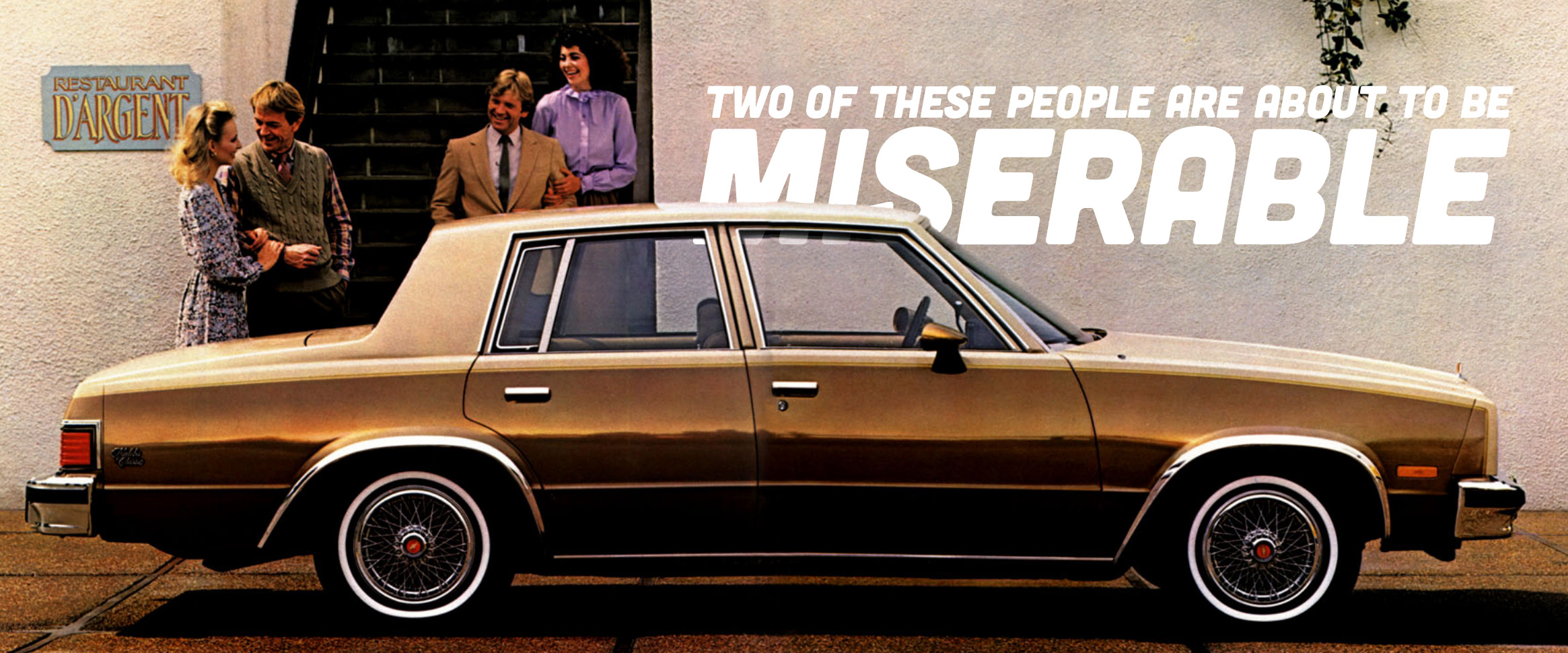
Now, I’ve heard a number of reasons why GM made the decision to make four-door sedans and wagons with rear door windows that wouldn’t roll down, the most common of which was that they wanted to have the rear door armrests be recessed into the door to maximize room.
What? What kind of bullshit is that? The one thing these boxy barges had was room; what they didn’t have was any good way to get airflow into those back seats. Sure, they had little vent windows, but those barely helped, and were just a kick in the ‘nads when you could see that vast acreage of glass that refused to budge.
Even in the back of cars owned by friends whose parents weren’t cheapskates and sprung for A/C, it’s not like there were AC vents in the back; they were up front, blocked by a big bench seat and the people in them, absorbing all the cool air.
Let’s be real here: GM did this because they were cheap. And that cheapness wasn’t just for the low-end Chevys, even moving up to a Pontiac Bonneville or Oldsmobile or Buick wouldn’t save you.
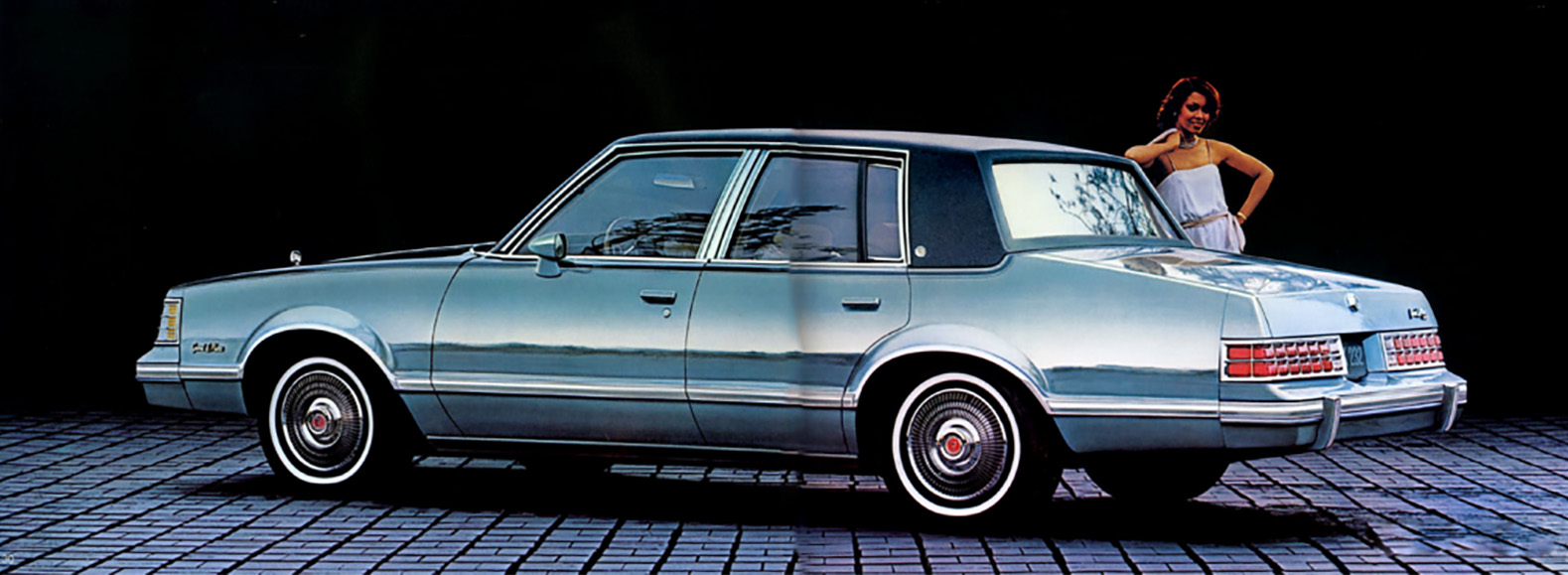
Yes, even the ones that had half-vinyl roofs. All the class in the world won’t keep you from getting asphyxiated.
But what really really chaps my once-sweaty ass about this is how the brochures described the rear door window situation:
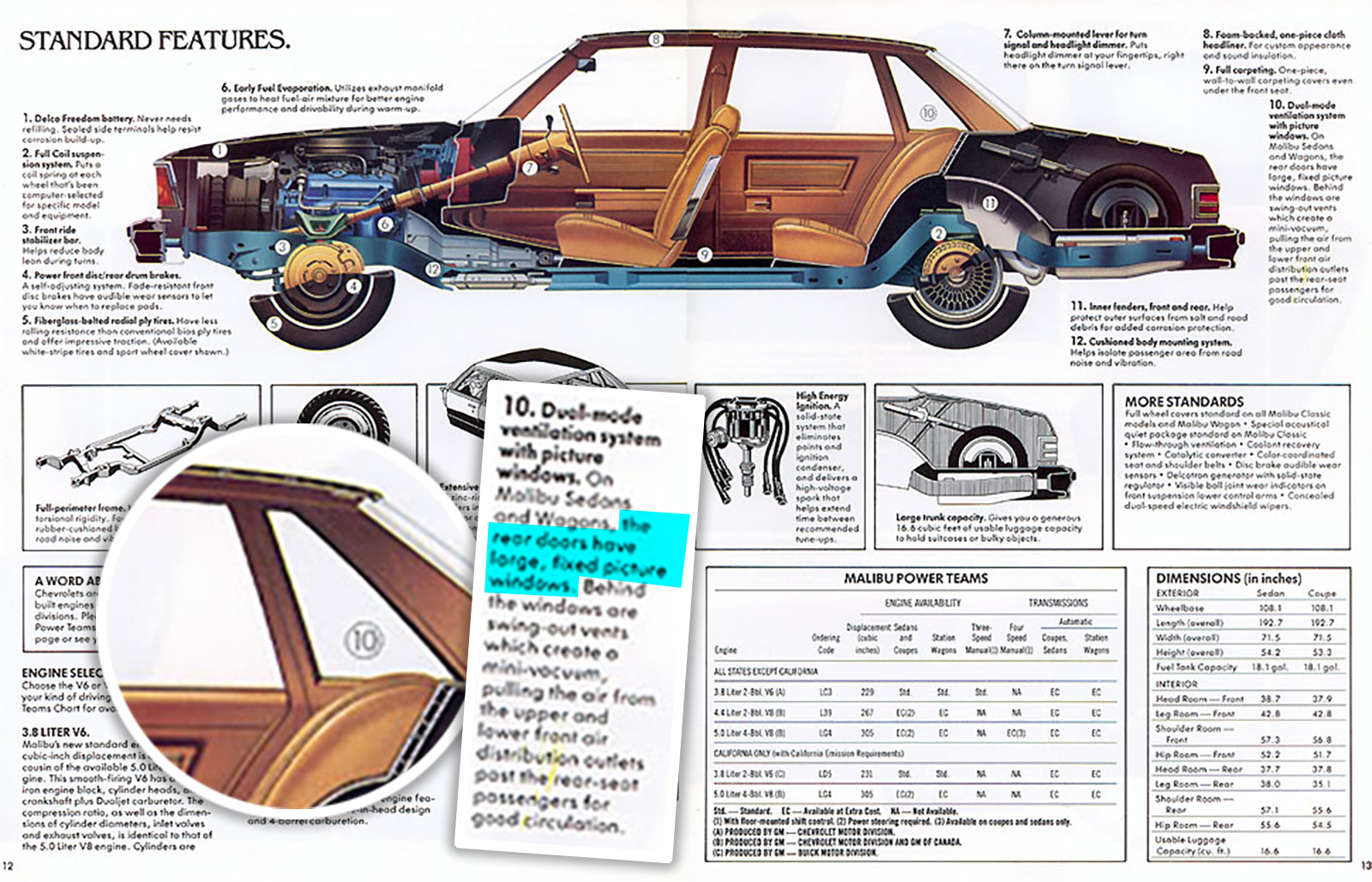
Here, let me find another brochure with a little clearer text:
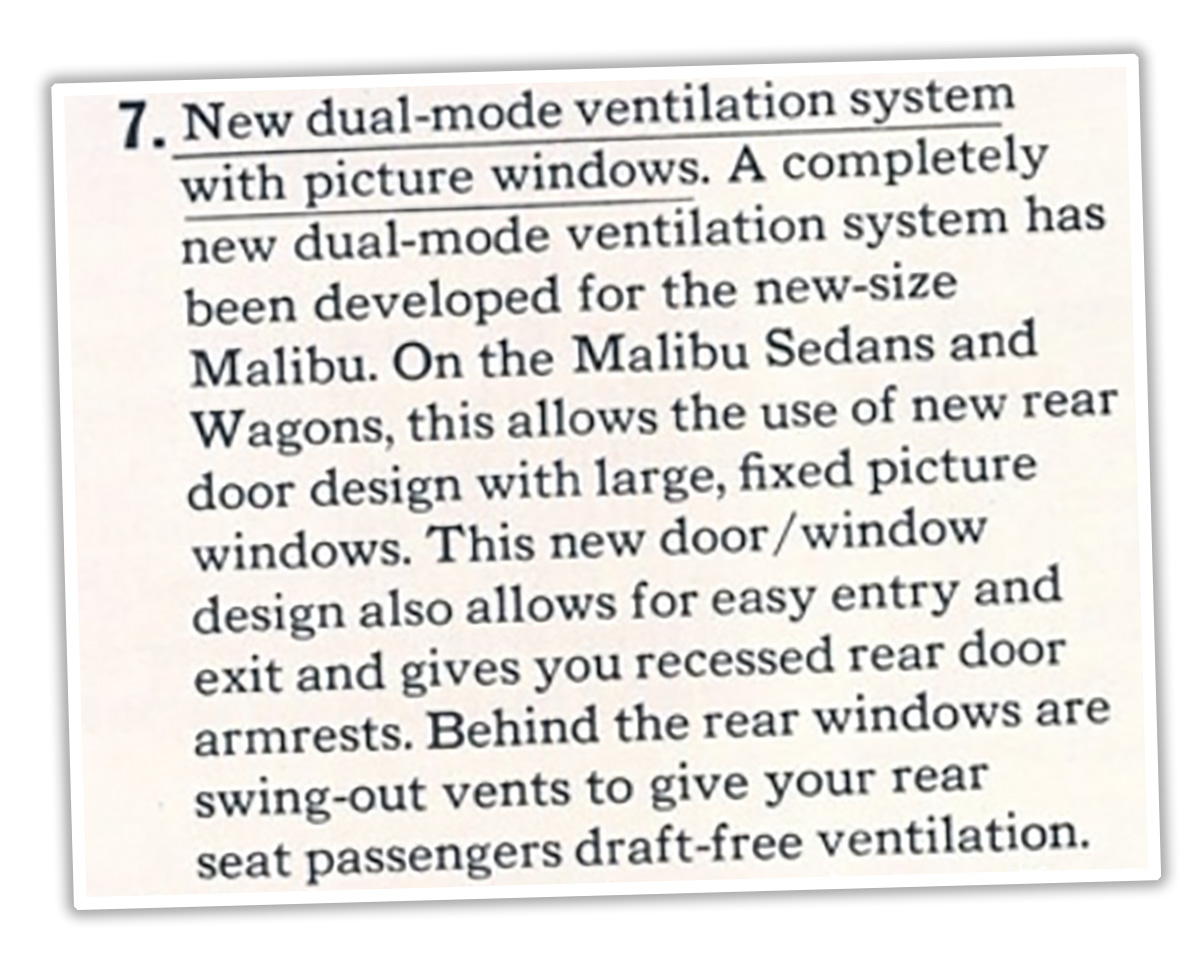
“…allows the use of new rear door design with large, fixed picture windows.”
The fuck does that even mean? Allows? Oh, thanks. “Picture windows” means what, the windows are clear? Fantastic. Great job. And “allows for easy entry and exit?” Who exactly was having trouble getting in and out of cars where the windows rolled down? This is a made-up problem. No one reading this was thinking “oh good, no more embarrassment when I can’t manage to get into a car that has windows that roll down.”
And what do they mean by a “new dual-mode ventilation system?” What’s the duality? The front gets ventilation and the rear gets fuck-all? Is that it? I guess that’s a sort of yin-yang duality there.
Also, “draft-free ventilation?” I’m not even sure what that means? Isn’t a draft just moving air? Isn’t that just ventilation? I think I’d rather they just leaned even harder into it and called the fixed windows Swell-Ter-Matic Secure-Air Stiflewindows or some shit like that.
I suppose it’s not really the copywriters’ fault. They were handed a real shit sandwich and asked to make it appealing, and they did the best they could.
I blame whatever bean counters were at GM that decided they needed to squeeze a few more cents out of these cars, with zero regard for the fact that they were going to build full-sized sedans and wagons with rear windows that were stubbornly stuck in place. Why did people accept this? What was our problem?
It was a different time, I suppose.
Picture windows. Ugh.

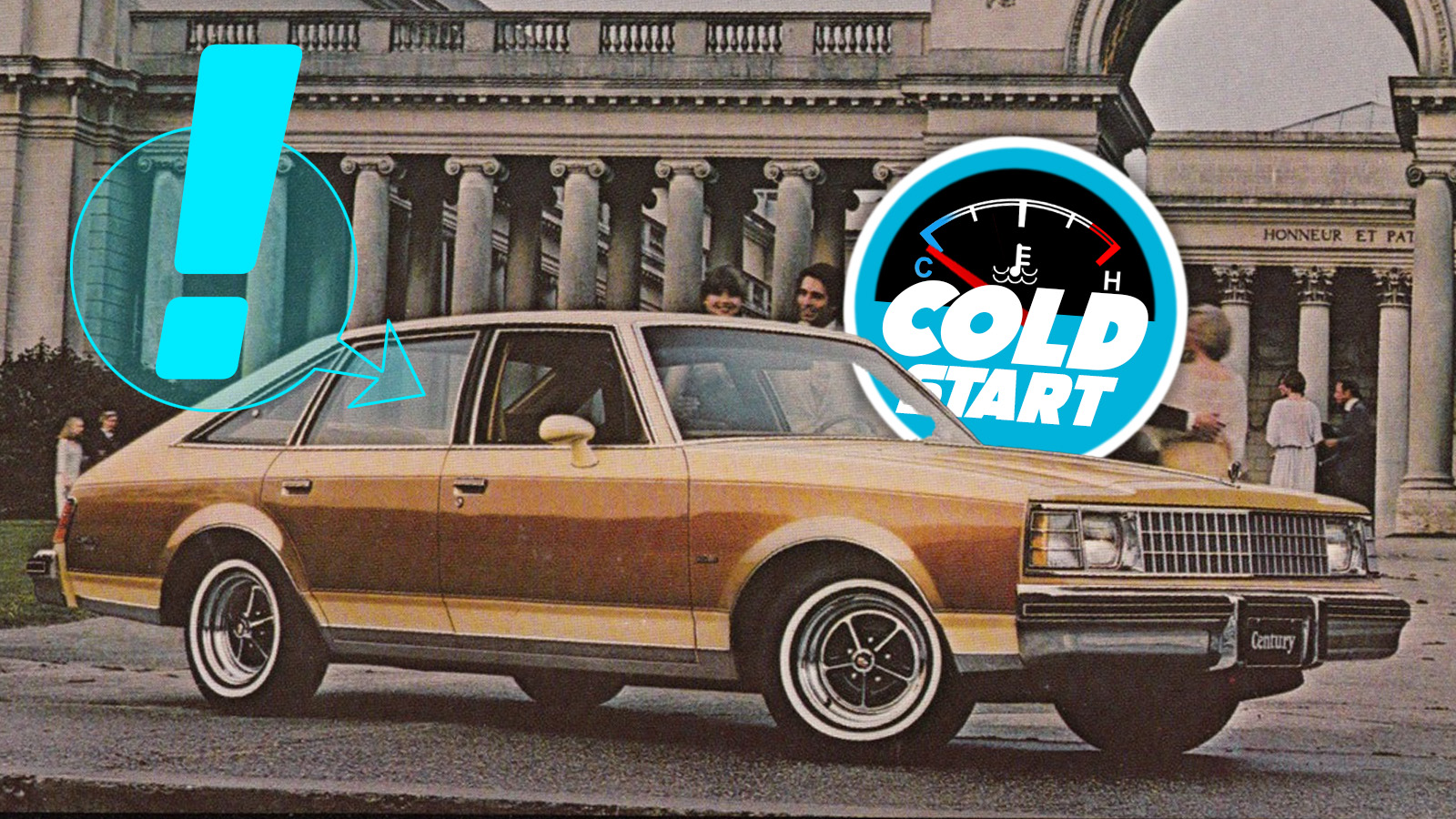







Only a few years earlier they were able to pull off completely roll-down rear quarter windows like the ’71 Cutlass Supreme I had in the late 80s, no B pilar at all and only a little leaking when it rained hard or you went through a car wash.
How can I be so infuriated with a malady I didn’t ever experienced?
CSB: That, uh, Citation, in the top photo? Family hauler for us 4 kids. I didn’t drive yet, but my older sister did. (It was even crappier and more uncomfortable than this article suggests). She went to get propane for the grill. She put the tank in the trunk, did not secure it at all. In the few minutes it took to get home it rolled around so much that the entire rear of the car was pocked with dents. Dents pushing outwards, of course, which was both hilarious and disturbing. Looked like an angry monster had been trapped… How she avoided exploding the tank is beyond me, but she was lucky in that regard.
That’s a Buick Century.
…l forgot the name, but not the discomfort and disappointment…
Didn’t realize nazi Tesla had an influence back then by making stupid designs like this, ha ha (like their fucking stupid “e”door handles (which have had all those victims die who couldn’t get out…in my opinion Tesla/Melon Husk are mass murderers because of that)
Fixed picture windows. Just the kind of luxury we were used to in our houses. Take note Stellantis. Here are a few ways to cut costs on your “new” products and capitalize on some classic American quality.
Early AI making a word salad based on bad automotive engineering. I understood rear windows that wouldn’t go all the way down, but these?
My old man bought a new car every year or two until his 1978 Bonneville. He hated the new cars so much he put 280,000 on it. I recall him complaining about windows that only went halfway down. I guess my young ears were spared his opinion of this horseshit, lest I repeat it at catholic school.
I remember baking in the backset of my family’s AMC Hornet that did not have rear windows that rolled down and no AC. I was never so glad to see a car get traded in.
I’m so glad our family car in that era was a Volvo, and the air conditioner worked. Granted the Honda Accord was a two door without AC, but it had pop out windows and cloth seats
Didn’t the first year K-car come with fixed rear windows? If memory serves, Chrysler learned and fixed that right away. I am too lazy to look it up.
I’ve chuckled at your previous rants on this topic but this was exactly the comic relief I needed today.
I saw the new ’78 Cutlass Sedan at a shopping mall where I worked when they first came out. The silicone sealer around the fixed window looked like it had been applied by a drunk chimpanzee. Naturally, GM tried to dress it up by claiming that the open vent window provided more airflow than if the window could actually open.
Are we sure about the years though? I inherited an 84 Olds Cutlass Supreme and samesies – the rear windows were “picture windows”
They actually mentioned this shit? I thought people bought them and didn’t realize the windows didn’t fucking roll down until they got the car home.
I’m pretty sure that was the most common scenario….
GM invented the Air Fryer.
Realistically, those little vent windows had nothing to do with temperature control and everything to do with evacuating cigarette smoke.
With the curved design of the rear door bottoms, the windows most likely could not have lowered all the way. They probably envisioned too many complaints from customers that the rear window lowering mechanisms were defective and just decided, “Screw it! If they’re gonna complain about those windows not lowering all the way, we’ll just make them not lower at all. That will help with the JD Power initial complaints surveys.”
“Swell-Ter-Matic” makes me happier than anything I’ve read today.
*Looks around at…everything*
Was it? Enshittification wasn’t coined in the 70s and 80s…
There is one way to open those windows.
Getting them closed again is a problem, though.
Nah, just need a trash bag and some duct tape.
When you look at the brochures for Ford Fairmont and Mercury Zephyr – it’s apparent that Ford thought people would want a similar rear ventilation – and offered the option of such louvers and vents in lieu of the rear quarter window on sedans and a smaller rear side window on coupes along with the vents (Standard on ES models). Of course the rear door windows dropped normally too – as standard.
It was a rare option which was dropped after a couple years.
I was just thinking that this is a particular Gen-X trauma that Jason’s getting off his chest and among people on the Slack, Beau’s probably closest in age to him. But as a kid he’d have mostly been hauled around in Fords.